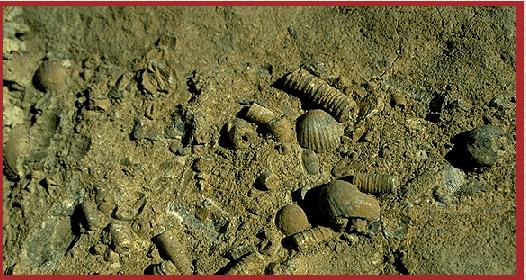 Lesson 5:
Lesson 5:
 Life's History: The Great Adventure
Life's History: The Great Adventure
|
 5.4
5.4
 The Nature of the Fossil Record
The Nature of the Fossil Record

|

|
Figure 5.4.1
 Fossils can be useful for dating layers of rock.
Fossils can be useful for dating layers of rock.
|
Steno's thinking not only introduced the concept of the history of life, but
also that of the history of the Earth, as readable from strata of rocks.
Nothing was as yet known about this history other than what was told in Genesis.
The time scale was still short: one of the leading scholars of
chronological studies, Archbishop Ussher of Armagh, had just
re-affirmed the time of the origin of the world as around 4000 B.C.
(He gave the precise year and the precise day, actually. In those
days, knowing Hebrew was considered more important than knowledge of
fossils when doing time scales.)
The first naturalist to dare to think about tens of thousands of years
(perhaps millions) was Georges Buffon (1707-1788). He also clearly separated human history
from the history in the fossils of the layered, well-indurated (hardened or cemented)
formations of the "Secondary". These layered rocks overlie the "Primary" crystalline rocks,
in the generalized scheme of the time. They are overlain by the "Tertiary", that is
layers of poorly consolidated rocks. (We still use the word "Tertiary", but no
longer speak of the other two.) Human history, Buffon thought, belongs with the last
of seven "epochs" of Earth history (just as recorded in Genesis). For much of Earth's
history, then, no humans were present to witness it. He removed humankind from the center
of time, and put us at the end of a long history.
Continuing this type of argument, fossils are used several decades later
(by the French paleontologists d'Orbigny and Cuvier, at the end of the 18th and in
the early 19th century) in arguing for a succession of worlds
separated by catastrophic events. This concept of Earth history seems
closer to Indian cosmogony than to Genesis. However, in this
catastrophist scheme, the Great Flood could be counted, if one was so
inclined, as the last great catastrophe. This was good for public
relations with the Church.
Successive creation and destruction of worlds was not the kind of thing a pragmatic
Englishman would readily subscribe to. While France was going through
unprecedented political upheaval, the English were busy making steam
engines and mining coal, under the stable 60-year rule of George III.
In this setting, geology became a commercially useful skill.
The "Father of English Geology" William Smith (1769-1839), known as "Strata
Smith" to his friends and colleagues, was educated in a village
school and trained as a surveyor in the field. He was trying to make
a living, and his interest in fossils was of a practical nature:
their presence in rock told him where he was in the stratigraphic
sequence. Looking at a road cut, he would know which formations
underlayed the land he was standing on, and whether it was a good
place to build canals or to look for coal or for groundwater. His
discovery that fossils are useful in civil engineering and mining (a
fact rediscovered by the oil industry in the early 20th century) gave
a great boost to both paleontology and geology, as sciences worth
pursuing and funding.
Strata Smith's no-nonsense attitude soon spread to English geologic theory. Gradualist Earth
history and gradualist biological evolution were subsequently
successfully promoted (by Charles Lyell and Charles Darwin,
respectively) to counter the catastrophist ideas. Their books
established the foundations of modern geology and biology.
Both Lyell and Darwin stressed detailed observation as a source of insight, and rejected
the sometimes untrammeled imagination of earlier writers who went for
the "big picture". This had a sobering effect. Also, it
made it respectable to do pedestrian descriptive research in geology
and in biology. Under the doctrine of uniformitarianism (present
processes explain what happened in the distant past) everything one
might observe was just about equally important. (The English
physicist Ernest later dismissed everything except Physics and
Chemistry as mere stamp-collecting.)
Today it is reasonably well established that the two contrasting approaches
of catastrophism and gradualism are both wrong when used alone. The truth
lies in the middle: during long periods (say, the middle Jurassic) evolution is
gradual. But separating the major periods in Earth history, there are
fundamental catastrophic changes, with an unusually large number of
extinctions.
|





















